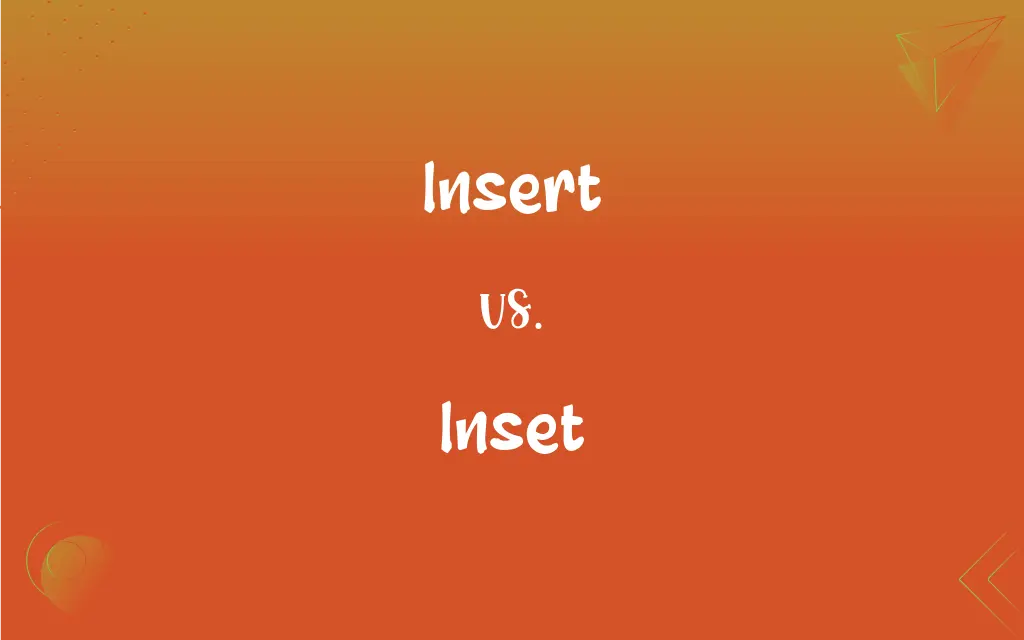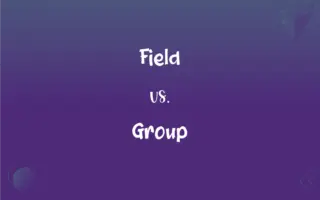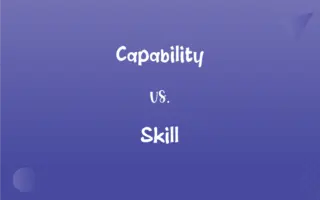Insert vs. Inset: What's the Difference?
By Aimie Carlson & Janet White || Updated on May 30, 2024
"Insert" refers to placing something into another, while "inset" denotes a smaller item set into a larger one. Both involve placing objects but differ in scale and integration.

Key Differences
"Insert" involves placing an object into another, like inserting a key into a lock. This action emphasizes the process of placing something inside. "Inset," on the other hand, refers to a smaller item embedded within a larger one, such as an inset image in a book. This term highlights the integration of a smaller element within a larger context.
While "insert" focuses on the act of placement, "inset" emphasizes the relationship between the embedded item and its larger surrounding. For example, inserting a coin into a slot contrasts with an inset gemstone in a piece of jewelry.
The usage of "insert" often implies a temporary or removable placement, like inserting a card into a machine. In contrast, "inset" usually suggests a more permanent or fixed integration, like an inset panel in a door.
"Insert" can be used as both a verb and a noun, describing the action or the item being placed, such as an insert in a magazine. "Inset" is primarily a noun, describing the embedded item itself.
In technical contexts, "insert" often refers to adding data or objects, like inserting a row in a spreadsheet. "Inset" in design contexts refers to detailed features within a larger design, like insets in architectural plans.
ADVERTISEMENT
Comparison Chart
Definition
Placing something into another
Smaller item set into a larger one
Focus
Action of placement
Relationship between items
Permanence
Often temporary
Often permanent
Usage
Verb and noun
Primarily noun
Context
General placement
Embedded design or feature
ADVERTISEMENT
Insert and Inset Definitions
Insert
To introduce something into a space.
Insert the plug into the socket carefully.
Inset
A small item set into a larger one.
The book featured a colorful inset map.
Insert
To add data or objects in a system.
Insert the new row into the spreadsheet.
Inset
An integrated component of a larger work.
The painting included a detailed inset of the artist's signature.
Insert
To place something into another thing.
She inserted the key into the lock.
Inset
A section embedded within a larger structure.
The dress had a lace inset at the neckline.
Insert
To include additional content.
Please insert the missing paragraph into the document.
Inset
Detailed feature in a design.
The door had intricate wood insets.
Insert
To put or set into, between, or among
Inserted the key in the lock.
Insert a shim between a door jamb and frame.
Inset
A piece designed to fit within another.
The table had marble insets on the top.
Insert
To put or introduce into the body of something; interpolate
Insert an illustration into a text.
Inset
To set in; insert.
Insert
To place into an orbit, trajectory, or stream.
Inset
To furnish with an inset.
Insert
To put into action
Inserted a rookie into the lineup.
Inset
A small map or illustration set within a larger one.
Insert
Something inserted or intended for insertion, as a picture or chart into written material.
Inset
A leaf or group of pages inserted into a publication.
Insert
(transitive) To put in between or into.
In order to withdraw money from a cash machine, you have to insert your debit card.
To make your proof easier to understand, I recommend you insert a few more steps.
Inset
A piece of material set into a garment as decoration or trim.
Insert
An image inserted into text.
Inset
An inflow, as of water.
Insert
A promotional or instructive leaflet inserted into a magazine, newspaper, tape or disk package, etc.
This software can print compact disc inserts if you have the right size of paper.
Inset
A channel.
Insert
A mechanical component inserted into another.
A threaded insert
Inset
(transitive) To set in; infix or implant.
Insert
(linguistics) An expression, such as "please" or an interjection, that may occur at various points in an utterance.
Inset
(transitive) To insert something.
Insert
(genetics) A sequence of DNA inserted into another DNA molecule.
Inset
(transitive) To add an inset to something.
Insert
(television) A pre-recorded segment included as part of a live broadcast.
Inset
A smaller thing set into a larger thing, such as a small picture inside a larger one.
Insert
A close-up shot used to draw attention to a particular element of a larger scene.
Inset
Anything inserted.
Insert
(audio effects) A plug-in that adds an effect to an audio track.
Inset
A small piece of material used to strengthen a garment.
Insert
(computing) A key to toggle between text insert mode and overwrite mode
Inset
To infix.
Insert
To set within something; to put or thrust in; to introduce; to cause to enter, or be included, or contained; as, to insert a scion in a stock; to insert a letter, word, or passage in a composition; to insert an advertisement in a newspaper.
These words were very weakly inserted where they will be so liable to misconstruction.
Inset
That which is inserted or set in; an insertion.
Insert
A folded section placed between the leaves of another publication
Inset
One or more separate leaves inserted in a volume before binding;
Insert
An artifact that is inserted or is to be inserted
Inset
A small picture inserted within the bounds or a larger one
Insert
(broadcasting) a local announcement inserted into a network program
Inset
An artifact that is inserted or is to be inserted
Insert
(film) a still picture that is inserted and that interrupts the action of a film
Inset
A piece of material inset to strengthen or enlarge a garment
Insert
Put or introduce into something;
Insert a picture into the text
Inset
Set or place in
Insert
Introduce;
Insert your ticket here
Insert
Fit snugly into;
Insert your ticket into the slot
Tuck your shirtail in
Insert
Insert casually;
She slipped in a reference to her own work
Insert
An item placed within another.
The magazine came with a special insert.
FAQs
What does "inset" mean?
"Inset" refers to a smaller item set into a larger one.
Can "insert" be used as a noun?
Yes, it can describe the item being placed, like a magazine insert.
What does "insert" mean?
"Insert" means to place something into another object or space.
Does "insert" imply permanence?
It often suggests a temporary placement.
Can "insert" refer to adding data?
Yes, like inserting a row in a spreadsheet.
Does "inset" emphasize the action of placing?
No, it emphasizes the relationship between the embedded item and its larger context.
Is "inset" related to detailed features?
Yes, like an inset map or design element.
Is "inset" used as a verb?
No, "inset" is primarily used as a noun.
Is "inset" used in design contexts?
Yes, it commonly describes embedded features in designs.
Does "insert" focus on the action or relationship?
It focuses on the action of placing something.
Is "inset" always permanent?
Usually, it implies a more fixed or integrated placement.
Can "insert" describe physical and digital contexts?
Yes, it applies to both physical placement and digital data addition.
Does "inset" apply to both physical and digital designs?
Mainly physical, but can apply to detailed digital designs.
Is "insert" more general than "inset"?
Yes, it covers a broader range of placements.
Is "inset" typically a minor feature?
Yes, it usually describes a smaller, detailed feature within a larger context.
Can "insert" describe introducing new content?
Yes, like inserting a paragraph into a document.
Does "inset" describe something larger than "insert"?
No, it describes something smaller within a larger item.
Can "insert" be temporary in nature?
Yes, often it suggests temporary placement.
Is "inset" specific to certain industries?
Common in design, architecture, and art.
Can "insert" refer to objects and content?
Yes, it applies to both physical objects and textual content.
About Author
Written by
Aimie CarlsonAimie Carlson, holding a master's degree in English literature, is a fervent English language enthusiast. She lends her writing talents to Difference Wiki, a prominent website that specializes in comparisons, offering readers insightful analyses that both captivate and inform.
Co-written by
Janet WhiteJanet White has been an esteemed writer and blogger for Difference Wiki. Holding a Master's degree in Science and Medical Journalism from the prestigious Boston University, she has consistently demonstrated her expertise and passion for her field. When she's not immersed in her work, Janet relishes her time exercising, delving into a good book, and cherishing moments with friends and family.































































